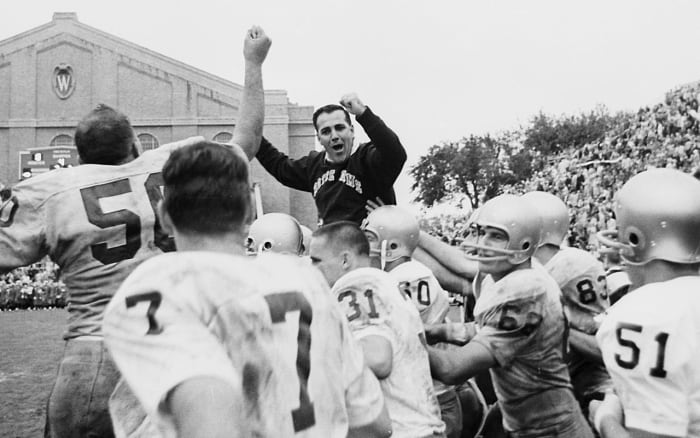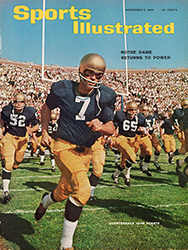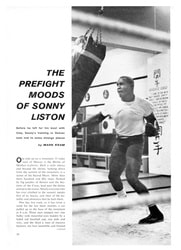Wake Up The Echoes!
Once every 10 years or so Notre Dame recoats the golden dome rising above its campus so that it glows brightly, especially during football season when the orange-and-red fire of autumn sweeps through the trees below. Last Saturday, as Notre Dame defeated Stanford 28-6 to remain unbeaten in five games, the dome on the main building seemed to be giving off beams of inspiration as it did in the days of Frank Leahy and Knute Rockne. Notre Dame is winning again.
Even before Notre Dame reached a stunning 5-0 record, its first since 1953, which was Frank Leahy's last season, there was a feeling among the students and the university's far-flung followers that this was the year and Ara Parseghian was the coach and 1964 would see a proud football tradition resurrected once more.
"It was more than a feeling, it was a fever," says Notre Dame Captain Jim Carroll, who plays linebacker. "We all caught the fever with the first words Coach Parseghian said to the squad. He said, 'We will win.' And the way he is—intense, enthusiastic, confident—you sort of felt he wouldn't allow anything else to happen. He's a wonderful coach."
Winning football games has twice before been a natural law at Notre Dame. It began under Knute Rockne in 1918. For 13 raucous years, through 1930, Rockne's teams were five times undefeated and three times national champions, winning an appalling 105 games while losing only 12. These teams were led by George Gipp and the Four Horsemen and Marchy Schwartz—all those folklore characters. "I say college football began with Rockne," says Ara Parseghian, violating the memory of the Princeton-Rutgers game of 1869.
Notre Dame's second hallowed period of success came under Frank Leahy. From 1941 through 1953 Leahy's teams were six times unbeaten and four times national champions. Leahy won 87 games, lost just 11. And these were the teams of Angelo Bertelli and Johnny Lujack and Leon Hart and Johnny Lattner, and they would have been a swell buy for CBS.
"With all of our tradition, you can just imagine how hungry our students have been during these lean years," says Athletic Director Ed Krause. "They know the history, but they've had nothing to yell about. It's easy to see why the fever has gripped them, and why Ara's enthusiasm got them from the beginning."
The fever erupted as early as one cold, snowy night last February when, spontaneously, 2,000 students on the all-male campus gathered on the slush-covered steps of Sorin Hall and chanted for Parseghian to come talk to them about a sport that was seven months away. Ara put on a muffler and talked.
"One thing about Notre Dame," says Parseghian. "It's like a service academy in a lot of ways. There is a closeness. There are no fraternities—just one big one, Notre Dame. And I tell you, it does have traditions. Knute Rockne is more alive around here today than a lot of live people somewhere else."
The more superstitious among Notre Dame's feverish followers had other reasons to be excited by Parseghian's arrival as head coach. The timeliness of it dredged up almost as many good omens as there were losses for the past few years. For one, exactly 10 seasons passed between the eras of Rockne and Leahy and now 10 have passed since Leahy retired and Parseghian asked Father Edmund Joyce, executive vice-president and athletic board chairman, for the job. For another, two men coached Notre Dame between Rockne and Leahy and only two, really—since Hugh Devore was a one-year "interim" coach—have tried to rebuild the Irish between Leahy and Ara. Parseghian is, incidentally, the first combination of non-Catholic and non-Notre Dame graduate to be coach. He is a dark-eyed Presbyterian of Armenian descent from Miami of Ohio. Finally, according to Notre Dame's publicity director and chief omen counter, Charlie Callahan, the Irish have usually done well when they have had quarterbacks whose names were unusual and un-Irish. There were Stuhldreher and Carideo under Rockne and there were Bertelli and Lujack and Guglielmi under Leahy, and now there is Johnny Huarte (see cover) under Parseghian.
Almost everyone at Notre Dame these days has an explanation for the team's surprising success—the new coach, better defense, the new substitution rules, prayer, luck, soft schedule so far—but one of the more valid ones is Quarterback Huarte, a slim, quiet, gentlemanly senior of Basque-German ancestry from Anaheim, Calif., whose name is pronounced Hugh-ert. Against Stanford, Huarte was worthy of the dozens of choruses of the familiar "Cheer, cheer for old Notre Dame, wake up the echoes..." which roared down from the packed crowd of 56,765. He completed 21 passes for 300 yards, a school record.
"I wouldn't have guessed at the start of spring training that Johnny would be our quarterback." says Jim Carroll. "He didn't move the ball too well on the ground, and he wasn't sharp on his signals. But, boy, did he come around."
Huarte came around on his throwing arm. Parseghian, a pass-conscious man who had just left Northwestern and Tom Myers, noted right off that Huarte had a quick delivery, dancing feet, could throw sidearm and off-balance, escape the rush, had good ability for faking hand-offs and a knack for what the coach calls "finding the open scam" on a pass pattern.
"I felt all along that if I could develop some confidence I'd get a chance," says Huarte. "Coach Parseghian gave me that confidence. He said I was his quarterback even if I fumbled and threw some interceptions. But he said not to throw too many."
Huarte almost did not get to throw at all. A shoulder separation in the spring at first looked as if it would require surgery. Ara had four doctors examine it and opinion was divided. Huarte made the decision to forgo surgery—he would have been lost for the season—and the shoulder mended itself. "Every time he hits a pass, I think how close we came to not having him around, and I shudder," says Parseghian.
Parseghian not only discovered a passer, he found a splendid receiver as well in Jack Snow, another California who has utilized his sure hands and his 215 pounds to pull in 34 passes for 595 yards, already another Notre Dame record. In what is basically a power-I formation, Snow plays a split end. "The Huarte-to-Snow combination is certainly our most dangerous weapon," says Parseghian. "Our best runners—Nick Eddy, Bill Wolski—are tough but not too fast."
Parseghian dislikes taking any credit for discovering the combination. "It's tough for me to talk about it," he says. "Here's Hugh Devore [now assistant athletic director], as wonderful a guy as there ever was. I don't want people saying, 'Why didn't Hugh discover them?" Nobody knows why an athlete suddenly develops [Huarte did not even earn his letter last year], why a pitcher wins 20 games one season and only half that many the next."
The fact is, however, that Parseghian is using pretty much the same personnel that could not win a year ago for Devore or even for Rockne's spirit. Ara has made some minor position shifts, and four sophomores are concealed in the defense, but five members of the offensive unit were regulars in 1963 and, counting Jim Carroll of the defense, there are actually six starters back.
"Platoons," says Parseghian with pleasant relish. "There's the story behind our five wins. We've got an offensive team and a defensive team, strictly using platoons under the new rules and, believe me, there is no depth. If more than two or three of our boys had to go both ways—well, I don't think the people around here would be so excited about our record right now."
Notre Dame's defensive unit, which is the best in the country against rushing, is given a standing ovation by the student section each time it trots off the field. Led by Carroll (78 tackles in five games) and Defensive Back Tony Carey (six interceptions), the defense has been almost as destructive to victims (Wisconsin 31-7, Purdue 34-15, Air Force 34-7, UCLA 24-0 and Stanford 28-6) as Huarte's passes and Snow's catches. A total of 10 touchdowns has been provided by the defense, either through fumble recoveries or interceptions. The second game of the season, against Purdue, Parseghian's emotional and important home opener, offers the best examples of Notre Dame's defensive alertness. The score was impressive, but it was spiraled by a 45-yard touchdown interception, a 57-yard blocked kick and runback and the recovery on Purdue's three-yard line of a 70-yard quick kick that accidentally touched a Boilermaker player.
The blocked punt was the result of a spectacular effort by two of Parseghian's brightest hopes for the future, sophomore Tackles Kevin Hardy (6 feet 5, 250), who slammed into the ball, and Alan Page (6 feet 5, 230), who scooped it up and ran for the touchdown. As Page ran, Parseghian ran along the sideline with him, shouting and gesturing.
"I sometimes get excited," smiles Ara.
Parseghian not only has a right to be excited about Notre Dame's defense, but also about its defensive coach, John Ray. "He's a genius," says Jim Carroll. Well, Parseghian thought so when he hired Ray from John Carroll University after he had taken the South Bend job. As a head coach at John Carroll, former Notre Dame player Ray specialized in defense, won 29 games and lost only six in five seasons. "I heard him talk about defense at a coaching clinic," says Ara, "and was tremendously impressed."
Says Linebacker Jim Carroll, "There are two or three boys on our defensive team that are playing great ball, and I think you have to say that Coach Ray is directly responsible."
Good as it is, the Notre Dame defense has yet to confront its severest tests. Navy, Pittsburgh, Michigan State, Iowa and Southern California—all potentially explosive teams, and old enemies—lie in wait. Ara Parseghian naturally believes his season has really only begun. "People are talking about Rockne and Leahy and bowl games—bowl games!—and win streaks. Why, there'll never be any more win streaks like Notre Dame and Oklahoma once had. Teams are too even today. With the teams we've still got to play, I live in constant fear."
Meanwhile, Notre Dame lives in constant oldtime frenzy. "The spirit on the campus is the highest since the days of Rockne," says Ed Krause, mentioning that name again. "I couldn't make it any plainer than that." Neither could Father John Moran, the elderly director of admissions, who left a hospital bed two weeks ago to see the UCLA game from a wheelchair. Nor could Frank Gaul, the senior chairman of the pep rally committee, who says, "We can finally cheer, not because Notre Dame was great in the '20s or '40s, but because they're great now."


